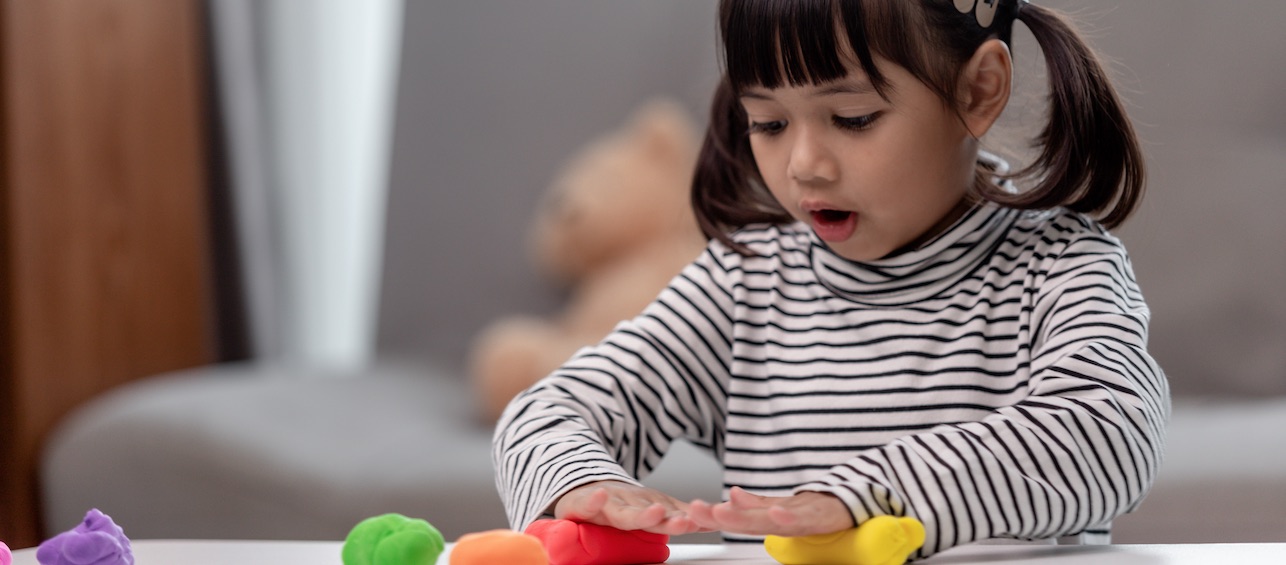When kids play, at a quick glance it may look like they’re just having a good time. But look at play deeper, and you’ll see lots of learning and development going on.
Play is a child’s first language. It’s how children of all ages experience and explore their world. Play provides the opportunity for kids to learn, practice important skills, and express complex thoughts and emotions.
In the medical setting, play can be used as a form of therapy with a specific goal or outcome in mind. Termed “play therapy,” this intervention is used by mental health providers to:
- Connect and build relationships with children and teens
- Work on important social, cognitive, physical and emotional skills
- Allow children and teens to express themselves without having to rely on words
- Help to raise self esteem as children work to resolve stressors and internal conflicts
As a Registered Play Therapist-Supervisor™, I often get asked about this intervention. It can look like I’m just having fun with a child. But there’s a lot more to it than that.
5 Things for Parents to Know About Play Therapy
Whether you are working through an issue with your child at home, or taking them to a therapist, there are many benefits of play therapy to be aware of. Here’s what I find important for parents to know about play therapy:
1. Play therapy is more than just typical play we see at home.
In play therapy, toys and therapeutic tools serve as the words kids use to express themselves. Children don’t necessarily have the words to explain complex things they experience in life. And even if they do have the words, it might be too difficult a topic to talk about.
Play allows therapists to work with kids on their level. We use specific toys, games and activities that are carefully selected based on each child’s needs and the reason that they have come in for an appointment. Tools we may use include:
- Toys that reflect real life, such as doll houses and medical kits. These allow children to play out their experiences and emotions.
- Art, clay and sand trays. These provide a tactile experience, and also allow kids to express emotions that are difficult to express through words.
- Therapeutic games. These can be used to help kids practice taking turns, manage frustrations, and build problem-solving skills.
- Rhythmic play, ball play, and other gross motor activities. These activities provide children the chance to regulate their nervous system, which is an important step to take place before expressing emotion.
2. Play therapy helps kids work on skills that are hard for kids.
As therapists, we observe children’s behaviors while they are playing, as well as their developmental level and interpersonal skills. Using play therapy, we can help children and teens to:
- Explore difficult feelings
- Learn to regulate their emotions
- Process crises and traumatic experiences
- Develop coping skills
- Work on problem-solving skills
- Develop empathy
Play therapy can help increase confidence, decrease anxiety and depression, and improve social skills.
3. Play therapy allows children to express themselves in a way that doesn’t require them to use words.
For a child I’m seeing, I might select a sand tray with miniature figurines and ask them to create a picture of their world. The child chooses figures meaningful to them. Then their brain goes where it needs to go. Using this intervention allows the child or teen to go deeper than words. Sometimes those big things in a child’s life are hard to talk about.
While they’re at work, I watch the nonverbal language being used. The sand tray and figurines can allow them to express things that are hard to voice. They also help kids and teens organize their thoughts and experiences. Then I can identify skills to work on or strengthen.
4. Play therapists use evidence-based treatments.
This means that the interventions play therapists use have been studied and proven to be effective. Studies continue today, and there’s been a growing body of research over the past five years showing the benefits of play inside and outside of therapy regardless of age.
The Association of Play Therapy recognizes best practices in the field and offers a rigorous credentialing program for play therapists. Through this program, licensed mental health professionals must meet requirements in graduate courses, play therapy instruction, and continuing education credits.
5. Play therapy dates back to the early 1900s.
The first recorded case of using play in therapy took place in 1909 when Sigmund Freud worked with a 5-year-old boy who had symptoms of anxiety. Play-based interventions have been in use at Cincinnati Children’s for many decades and are used by psychologists, social workers, child life specialists, and others who provide counseling services to families. They are also often used in clinical settings to explain procedures to patients and families.
What to Look for in a Therapist
Play therapy offers so many benefits to families. If you are looking for a therapist for your child, I strongly encourage you to ask about how they use play therapy in their practice. Here are a few other things to keep in mind as you seek out professional help:
- Look for therapists who are well trained in working with children.
- Talk with them about how they use play in their sessions.
- Ask how they include parents in their sessions. While there’s important individual work to be done in therapy, there’s also a lot of value in family therapy.
- Once you start working with them, ask what they’re seeing in their sessions with your child so you have a better understanding of what’s going on and what things you can work on with your child at home.







Speech language pathologists at Cincinnati Children’s also use play as a foundation to build and/or regain both verbal and non-verbal language, speech, voice, fluency, and pragmatic skills. For children, it is a natural platform and critical foundation in learning to communicate with others.